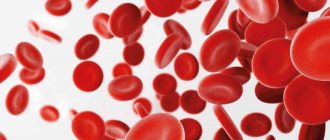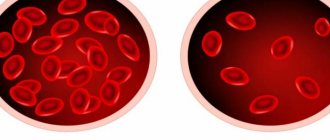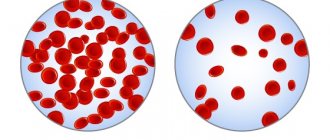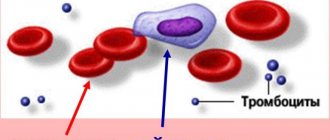What is erythropoietin?
Erythropoietin is a hormone that helps the body maintain optimal oxygen levels. To do this, it stimulates the production of red blood cells or red blood cells.
Red blood cells provide our tissues with oxygen and remove carbon dioxide. When oxygen levels drop, erythropoietin helps replace the loss by increasing the production of red blood cells and hemoglobin. Here's how it happens:
The kidneys have specialized cells that can detect when oxygen levels in the blood are low. If this is the case, the kidneys produce more erythropoietin. The hormone triggers the maturation of hematopoietic stem cells in the bone marrow. These are the precursors of red blood cells, which with the help of erythropoietin turn into full-fledged cells.
Erythropoietin
General information about the study
Erythropoietin is a hormone primarily produced in the kidneys. It is released into the bloodstream in response to oxygen deprivation (hypoxia). Erythropoietin enters the bone marrow, where it begins to stimulate the transformation of stem cells into red blood cells. Red blood cells contain hemoglobin, a protein that is capable of carrying oxygen from the lungs to organs and tissues. Normally, the lifespan of red blood cells is about 120 days, they have the same size and shape.
The body tries to maintain approximately the same number of circulating red blood cells. When the balance between the formation and destruction of red blood cells is disturbed, anemia develops. If too few red blood cells are produced in the bone marrow or too many are lost due to blood loss or destruction (hemolysis) caused by abnormal red blood cell size, shape, function, or other causes, the amount of oxygen carried to the organs is reduced. In response, the kidney produces erythropoietin, which is then transported by blood to the bone marrow, where it stimulates the formation of red blood cells.
Red blood cell production is affected by bone marrow function, adequate dietary intake of iron, vitamin B12, and folic acid, as well as the production of erythropoietin and the ability of the bone marrow to respond to appropriate amounts of this hormone.
The production of erythropoietin depends on the severity of oxygen deprivation and the ability of the kidneys to produce the hormone. It is active in the blood for a short time and is then excreted in the urine. Once the number of red blood cells rises after a deficiency, the kidneys begin to produce less erythropoietin. However, if they are damaged and/or cannot create enough erythropoietin, or if the bone marrow does not respond adequately to enough erythropoietin, anemia may develop.
When benign or malignant tumors of the kidneys (or other organs) form, excessive amounts of erythropoietin are produced, resulting in too many red blood cells - polycythemia develops. This leads to an increase in circulating blood volume, an increase in its viscosity and blood pressure.
What is the research used for?
- To distinguish different types of anemia from each other and find out how the level of erythropoietin corresponds to the severity of anemia. The need for this study, as a rule, is due to some abnormalities in the general blood test, which includes determining the number of red blood cells, hemoglobin, hematocrit, and reticulocytes. The results of such an analysis make it possible to confirm the diagnosis of anemia, determine its severity and the cause that caused it.
- To find out whether anemia is caused by a lack of erythropoietin or whether this deficiency aggravates existing anemia of another origin.
- To assess the ability of the kidneys to produce sufficient amounts of erythropoietin in patients with chronic renal failure.
- To find out whether polycythemia is caused by excess production of erythropoietin.
When is the study scheduled?
- When the patient's anemia is not explained by iron, vitamin B12 or folic acid deficiency, hemolysis or blood loss.
- When red blood cells, hemoglobin and hematocrit are reduced, and reticulocytes are normal or below it.
- If necessary, differentiate between the causes of anemia: suppression of bone marrow function and lack of erythropoietin.
- When you need to determine how much chronic renal failure affects erythropoietin levels.
- If necessary, ensure that polycythemia is not caused by excess production of erythropoietin.
Why is erythropoietin deficiency dangerous?
If erythropoietin production is reduced or impaired, blood oxygen levels remain low or will fall further. This is dangerous because it leads to several pathologies, including anemia and hypoxia. When they occur, the body's tissues receive insufficient oxygen and cannot function normally.
Symptoms of anemia:
- fatigue
- dizziness
- dyspnea
- weakness
- headache
- pale skin
- cardiopalmus
A lack of erythropoietin also reduces the body's ability to adapt to changes in altitude and intense physical activity.
Diseases such as AIDS, inflammatory diseases and some types of cancer can lead to low levels of erythropoietin. Lack of oxygen can aggravate these and other chronic diseases.
Mild cases of anemia may not require any treatment, especially if there are no symptoms. However, in more severe cases, iron supplements or erythropoietin-stimulating drugs may be needed. Erythropoietin therapy has been shown to be an effective treatment for anemia in patients with chronic kidney disease, as well as in patients suffering from cancer, HIV, and organ transplants.
How is erythropoietin controlled?
Although the exact mechanisms that control erythropoietin production are poorly understood, it is well known that specialized cells in the kidneys are able to detect and respond to low oxygen levels by increasing erythropoietin production. When there is enough oxygen in the circulation, erythropoietin production decreases, but when oxygen levels decrease, erythropoietin production increases.
This is an adaptive method because it promotes the production of more red blood cells to transport more oxygen throughout the body, thereby increasing tissue oxygen levels.
For example, erythropoietin production increases when moving to higher altitudes. This is because the air pressure is lower, the oxygen pressure is lower and therefore less oxygen is absorbed into the blood, which stimulates the production of erythropoietin. In conditions of low oxygen levels, people are at risk of developing hypoxia - oxygen starvation.
Hypoxia can also occur with poor ventilation, such as with emphysema or cardiovascular disease. Erythropoietin production is reduced in kidney failure and various chronic diseases such as AIDS, some types of cancer, and chronic inflammatory diseases such as rheumatoid arthritis.
What does excess erythropoietin mean?
Increasing erythropoietin levels causes the bone marrow to produce more red blood cells. Constantly elevated levels of this hormone signal a chronic lack of oxygen in the blood, for example, due to iron deficiency anemia. Also, an increase in erythropoietin levels can be caused by a tumor that secretes the hormone. For example, renal cell carcinoma.
In rare cases, too many red blood cells can cause a condition known as secondary polycythemia. It is associated with a number of serious health risks:
- increased blood viscosity
- less efficient blood supply and oxygen saturation
- high blood pressure in the lungs
- life-threatening blood clots
- stroke
What happens if I have too much erythropoietin?
What happens if I have too much erythropoietin?
Excess erythropoietin occurs due to chronic low oxygen levels or due to rare tumors that produce high levels of erythropoietin. This causes a condition known as polycythemia, which is an increased number of red blood cells. For many people, polycythemia does not cause any symptoms. However, there are general and nonspecific symptoms, including weakness, fatigue, headache, itching, joint pain and dizziness.
Is it worth using erythropoietin in sports?
In recent decades, professional athletes have discovered significant benefits from erythropoietin. This hormone significantly increases the absorption of oxygen into tissues, which can increase endurance and performance.
How are athletic achievements and genetics related?
Erythropoietin is part of a group of blood doping products that are prohibited by the Medical Commission of the International Olympic Committee (IOC) and the World Doping Agency. One of the reasons for the ban was the high health risk.
The use of erythropoietin as a doping agent results in abnormally high red blood cell counts. Blood thickening occurs and the risk of serious side effects increases:
- allergic reactions
- blood clots
- flu-like symptoms
- heart attack
- high blood pressure
- pulmonary embolism
- seizures
- stroke
What happens if I have too little erythropoietin?
If you have too little erythropoietin, which is usually caused by chronic kidney disease, you will have fewer red blood cells and you will be anemic. Erythropoietin was produced synthetically to treat anemia resulting from chronic renal failure. It is also prescribed to patients with other rarer types of cancer.
Professional athletes have used this type of erythropoietin (known as blood doping) to improve their performance, especially to increase endurance. Artificially increasing erythropoietin levels produces more hemoglobin and red blood cells and therefore improves the amount of oxygen delivered to tissues, especially muscles. This can improve performance, although this type of doping practice is prohibited by most professional sports committees.
ONLINE REGISTRATION at the DIANA clinic
You can sign up by calling the toll-free phone number 8-800-707-15-60 or filling out the contact form. In this case, we will contact you ourselves.
If you find an error, please select a piece of text and press Ctrl+Enter
What affects the production of erythropoietin?
Here's what contributes to decreased oxygen levels in the blood and increased production of erythropoietin:
- high altitude
- hypoxia
- lung diseases
- heart disease
High altitude
At higher altitudes, air pressure is lower, which means there is less oxygen in each breath. The body compensates by increasing the production of erythropoietin and red blood cells to maintain stable oxygen levels in the blood. This response helps combat symptoms of altitude sickness caused by decreased oxygen levels.
☝️When adapting to high altitudes, different people show big differences: some quickly produce more erythropoietin, others much more slowly.
The body's response to high altitude is partly determined by genetics. Populations that have traditionally lived at high altitudes for thousands of years, such as the Himalayan Sherpas, produce more erythropoietin and have, on average, more red blood cells than people living at sea level.
What do the test results mean?
If erythropoietin is increased and the number of red blood cells is reduced, then these are manifestations of anemia caused by inhibition of the hematopoietic function of the bone marrow. Anemia combined with a decrease in erythropoietin levels indicates that the kidneys are not producing enough of it.
With excessive production of erythropoietin by the kidneys, both the level of the hormone itself and the content of red blood cells in the blood increase - erythrocytosis develops. Other types of polycythemia are not usually associated with high concentrations of the hormone.
Erythropoietin can also moderately increase with iron deficiency anemia, very low hemoglobin levels, bone marrow tumors, oxygen deprivation, pregnancy, and after chemotherapy treatment.
A moderate decrease in erythropoietin was noted in rheumatoid arthritis and multiple myeloma. Severe reductions occur when there is excess red blood cell production due to bone marrow overgrowth, after a recent bone marrow transplant, and in chronic renal failure.






